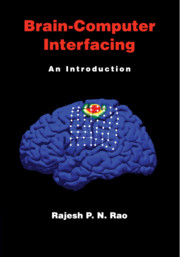Book contents
- Frontmatter
- Dedication
- Contents
- Preface
- 1 Introduction
- Part I Background
- Part II Putting It All Together
- Part III Major Types of BCIs
- 7 Invasive BCIs
- 8 Semi-Invasive BCIs
- 9 Noninvasive BCIs
- 10 BCIs that Stimulate
- 11 Bidirectional and Recurrent BCIs
- Part IV Applications and Ethics
- Appendix Mathematical Background
- References
- Index
- Plate Section
9 - Noninvasive BCIs
from Part III - Major Types of BCIs
Published online by Cambridge University Press: 05 October 2013
- Frontmatter
- Dedication
- Contents
- Preface
- 1 Introduction
- Part I Background
- Part II Putting It All Together
- Part III Major Types of BCIs
- 7 Invasive BCIs
- 8 Semi-Invasive BCIs
- 9 Noninvasive BCIs
- 10 BCIs that Stimulate
- 11 Bidirectional and Recurrent BCIs
- Part IV Applications and Ethics
- Appendix Mathematical Background
- References
- Index
- Plate Section
Summary
A holy grail of BCI research is to be able to control complex devices using noninvasive recordings of brain signals at high spatial and temporal resolution. Current noninvasive recording techniques capture changes in blood flow or fluctuations in electric/magnetic fields caused by the activity of large populations of neurons, but we are still far from a recording technique that can capture neural activity at the level of spikes noninvasively. In the absence of such a recording technique, researchers have focused on noninvasive techniques such as EEG, MEG, fMRI, and fNIR, and studied how the large-scale population-level brain signals recorded by these techniques can be used for BCI.
Electroencephalographic (EEG) BCIs
The technique of EEG involves recording electrical signals from the scalp (Section 3.1.2). The idea of using EEG to build a BCI was first suggested by Vidal (1973), but progress was limited until the 1990s when the advent of fast and cheap processors sparked a surge of interest in this area, leading to the development of a variety of EEG-based BCI techniques.
Information
- Type
- Chapter
- Information
- Brain-Computer InterfacingAn Introduction, pp. 177 - 209Publisher: Cambridge University PressPrint publication year: 2013
Accessibility standard: Unknown
Why this information is here
This section outlines the accessibility features of this content - including support for screen readers, full keyboard navigation and high-contrast display options. This may not be relevant for you.Accessibility Information
- 1
- Cited by
